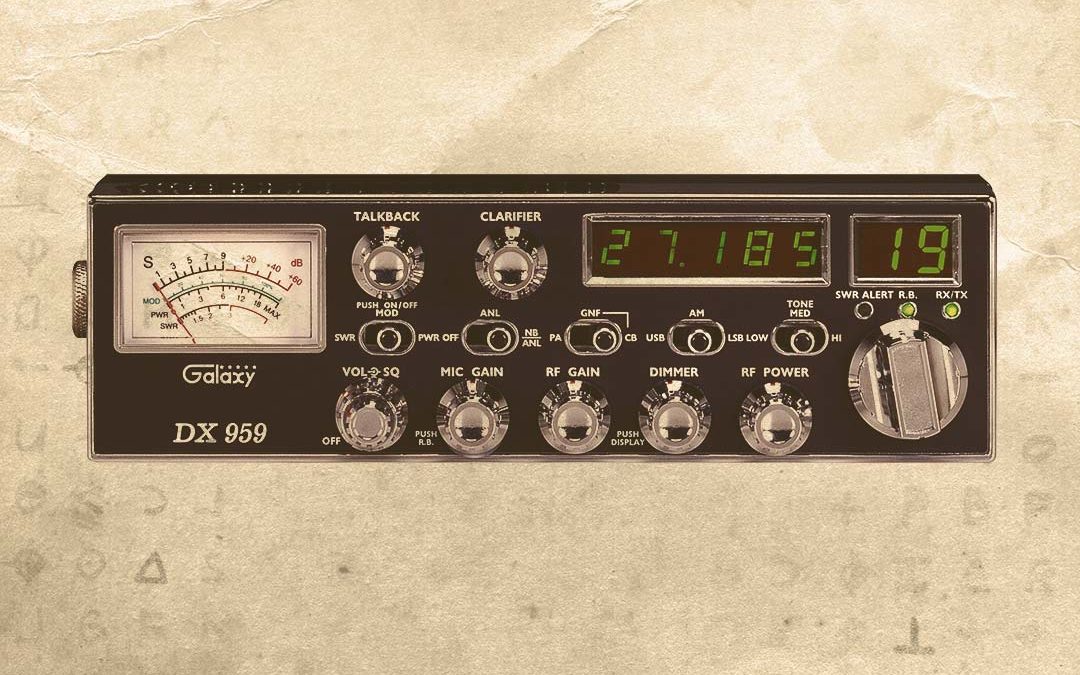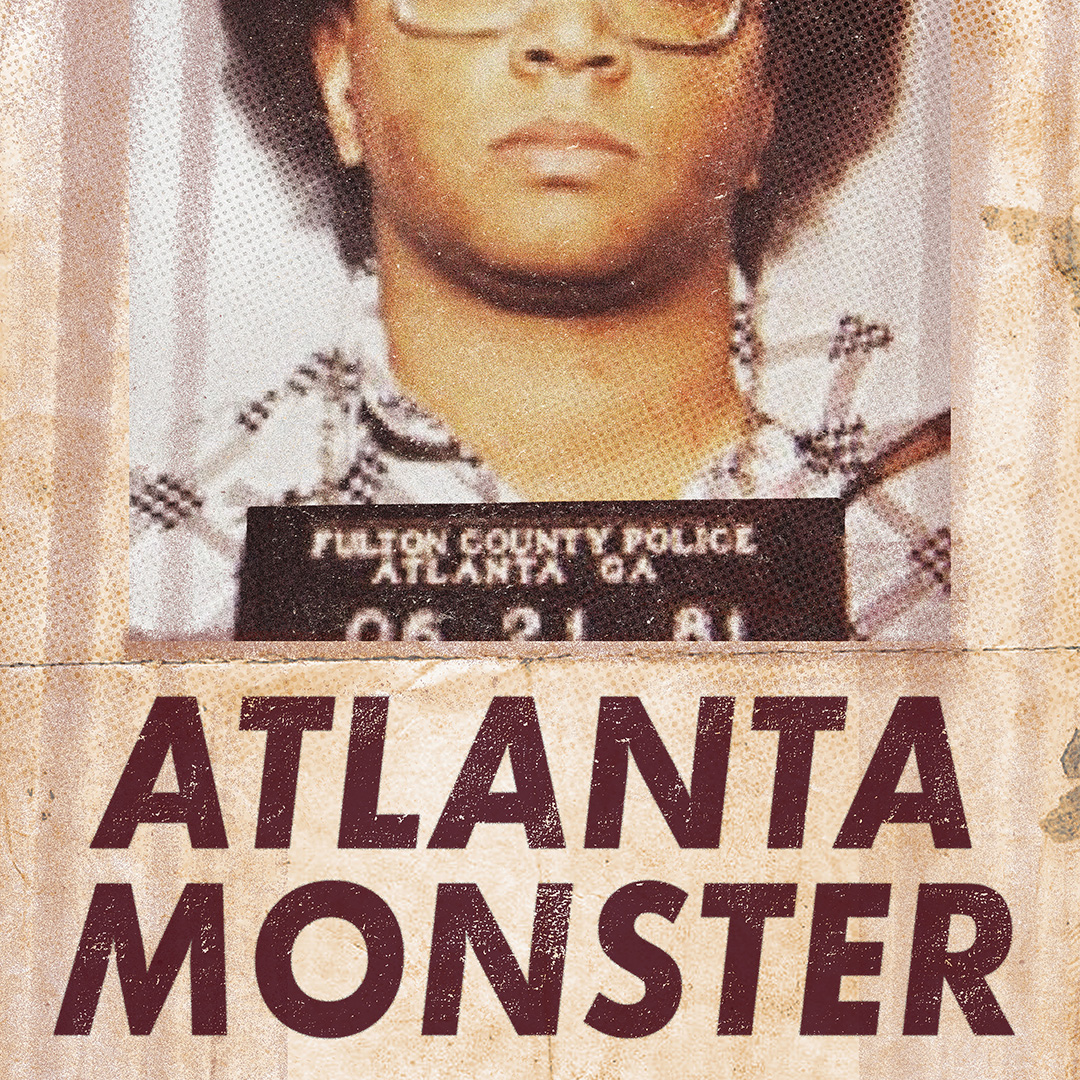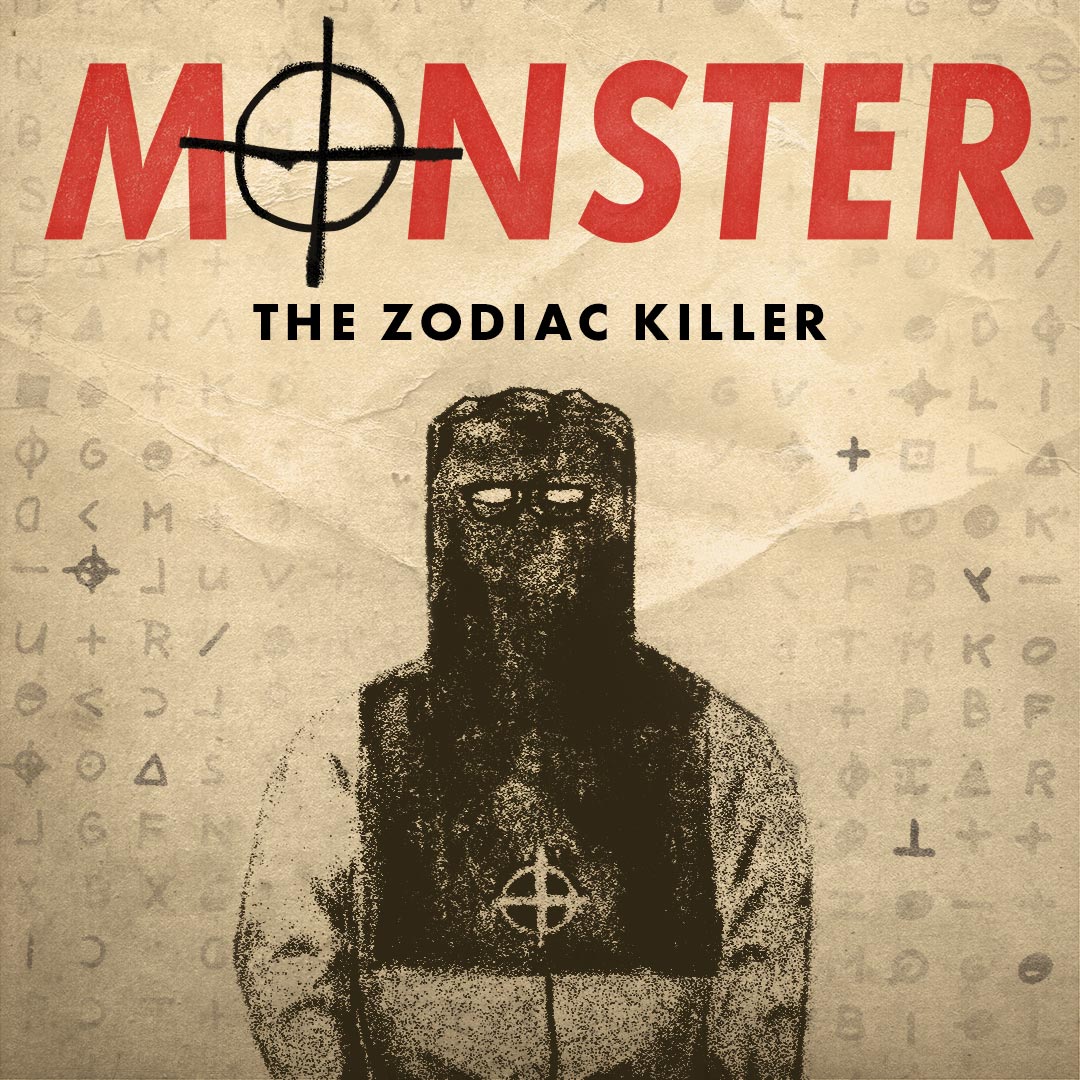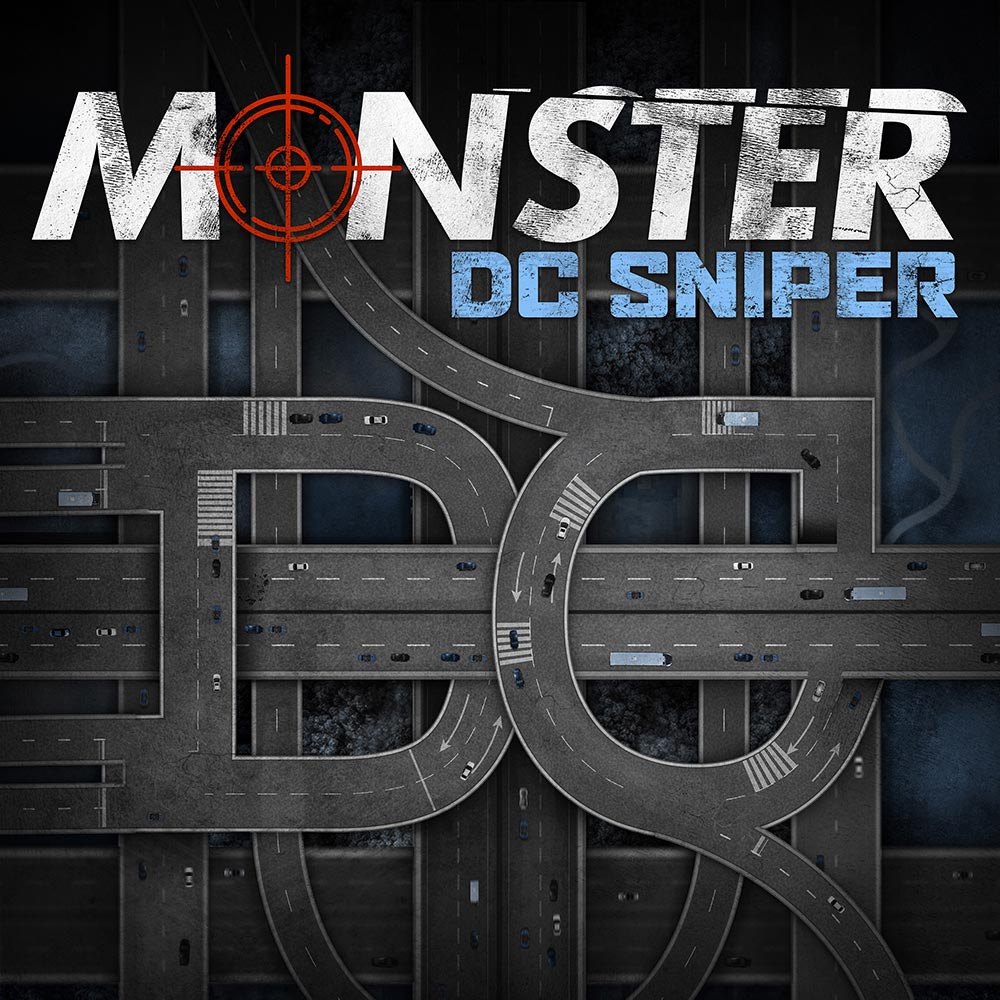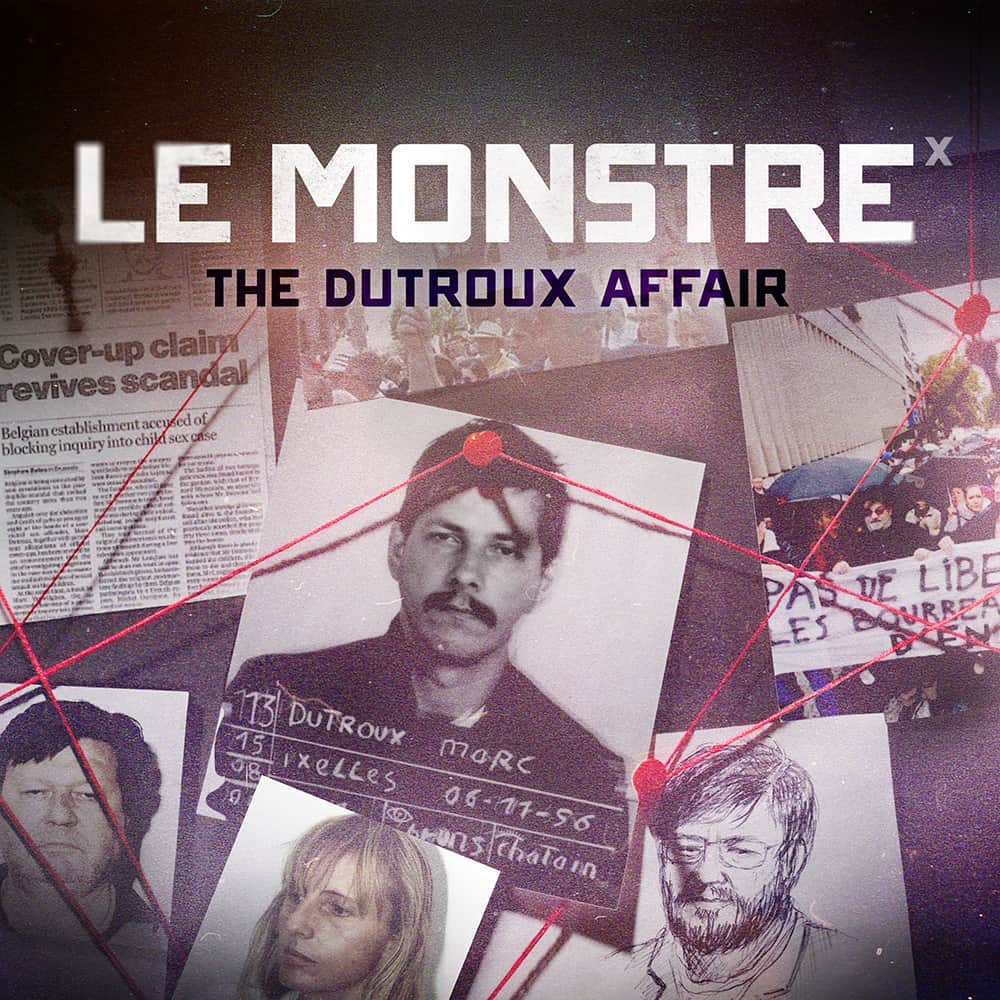15 • Legacy
A frightening final theory.

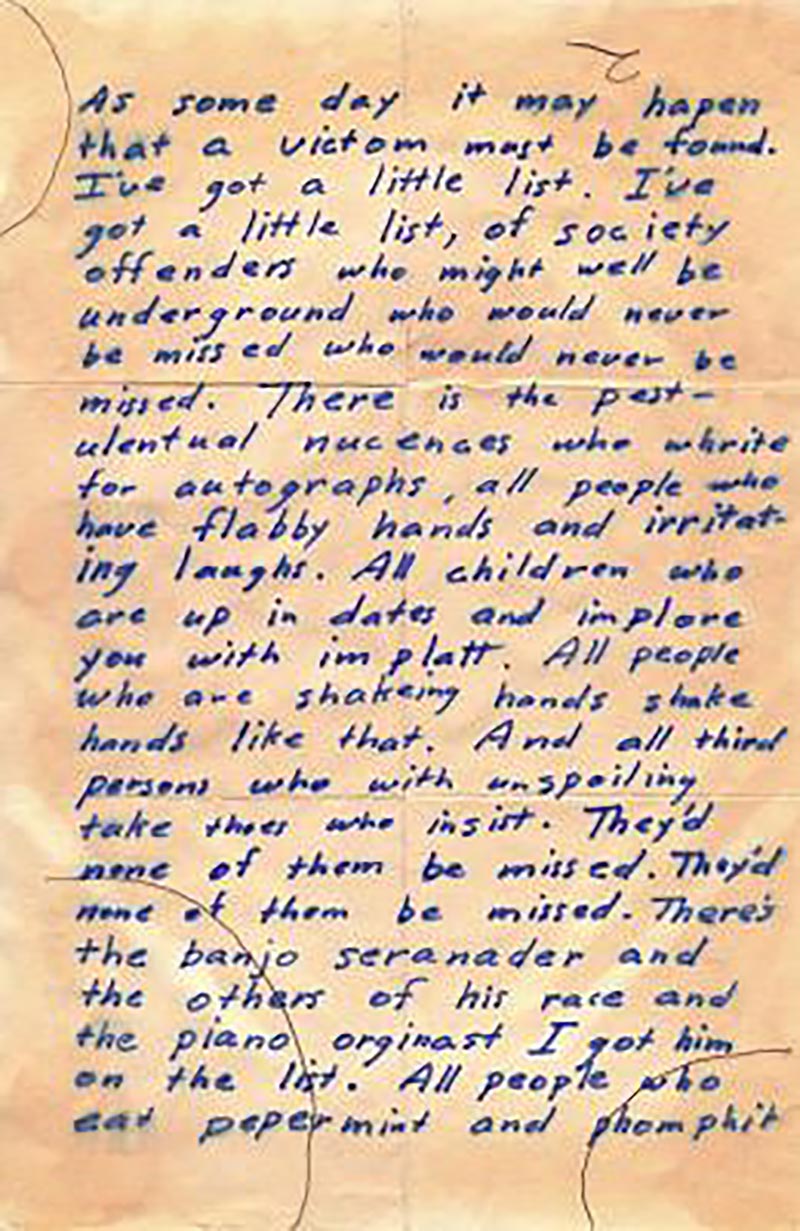
Many wonder about the Zodiac’s apparent fascination with The Mikado, a Gilbert and Sullivan opera. In three later letters, the Zodiac paraphrased lyrics from The Mikado.
In fact, the Zodiac’s letters alluded to many works of popular culture.
– Matthew Frederick, Host, Monster: The Zodiac Killer
Now, if you contrast a film like Silence of the Lambs with a film like Natural Born Killers, it deals with many of the same issues. But rubs our noses in the fact that we make serial killers celebrities.
– David Schmid, English professor at the University of Buffalo
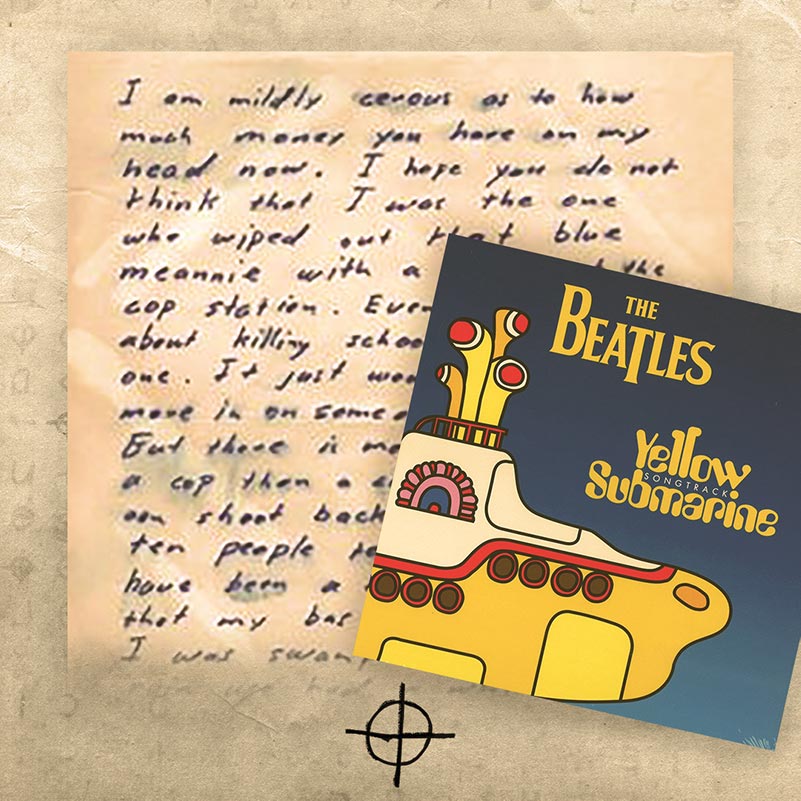
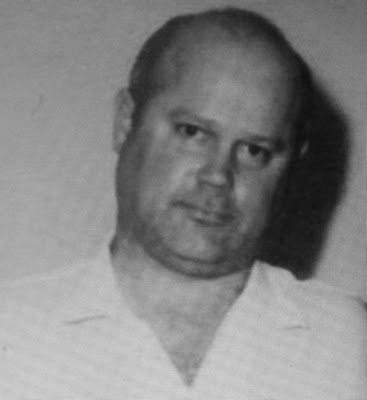
Is it possible that prime suspect Arthur Leigh Allen was actually a copycat killer? He admitted to police he had bloody knives in his car on the day of the Lake Berryessa stabbings. Knives he claimed he used to slaughter chickens. Could it be that Allen was responsible for the Berryessa stabbings? But had nothing to do with the other Zodiac murders or any of the letters?
– Matthew Frederick, Host, Monster: The Zodiac Killer
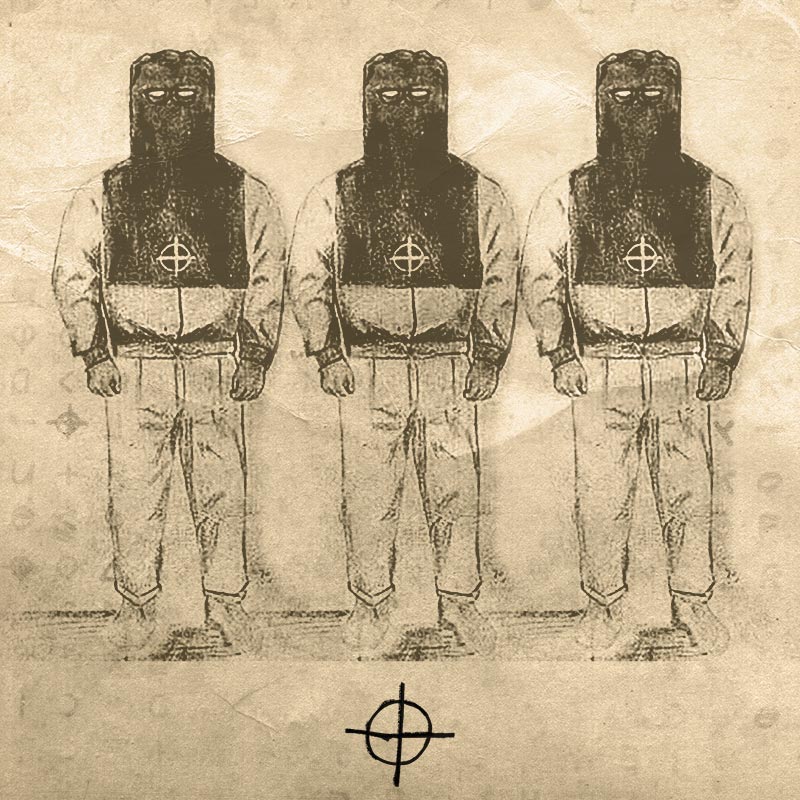
There's a theory that the attack at Lake Berryessa was a copycat killer, who was inspired by what he read in the newspapers.
– Michael Butterfield, Zodiac expert
Transcript
Speaker 1: The views and opinions expressed in this podcast are solely those of the podcast author, or individuals participating in the podcast, and do not necessarily represent those of iHeartMedia, Stuff Media, or its employees.
Matt Frederick: Over the course of our investigation, we conducted nearly 100 interviews, and combed through dozens of police records and old newspaper articles. We traveled to the crime sites and unearthed hours of archival footage that hadn’t been heard since its original broadcast.
Matt Frederick: It’s easy to get lost in this 50-year-old mystery. As we investigated the case, we met people who were there when it all started. Their stories are an important reminder that this case is rooted in a very real tragedy.
Matt Frederick: Through all these conversations, we also discovered new facts about the case, and began to see cracks in the stories engraved in the Zodiac lore … even going back to the first attack in the Bay Area, the murders of Betty Lou Jensen and David Faraday. Just five days before Christmas, 1968.
continue reading
John Henslin: Betty Lou was really head over heels for David. I didn’t meet him until the night that they were killed, ‘cause they came to our house that night. My name’s John Henslin, and I grew up in Vallejo, California. I lived there until I was 20. Betty Lou was my sister’s best friend since kindergarten. She came to the house quite often. She drew a lot, and she was really into Snoopy, and she wanted to be an artist.
John Henslin: Betty Lou and David came to our house that night. This was supposed to have been their first date, which really wasn’t their first date because they were seeing each other at school. He went to Vallejo High, and she went to Hogan, which is across town. But my sister said that they would go see each other at lunchtime and stuff like that. They were dating for a while, but not officially as far her parents were concerned.
John Henslin: My sister, she had a boyfriend that was a little older, had a car. Her and Betty Lou and David and her boyfriend were supposed to go to San Francisco. It was the story that they were telling my parents that night. And my sister’s boyfriend was late showing up.
John Henslin: Finally, my sister said, “Go wherever you need to go, because I can’t find my boyfriend.” She walked them out to the car, and they made plans to go out that next morning to go shopping. Betty Lou and David drove off, and that was the last time that we saw them.
John Henslin: It really affected my sister a lot, ‘cause the phone rang the next morning. It was a friend across the street who heard on the radio that Betty Lou was killed. My sister just went nuts. It was five days before Christmas; she was 16, and it just ruined everything for everybody.
John Henslin: What’s pretty sad and the things that went on with the police and everything about what they thought happened and they’re trying to find out what happened. It was hard on my sister. ‘Cause in those days, they went down to the police station and talked to the detectives without my parents or anything, ‘cause they didn’t have that Miranda thing or any of that kind of stuff. They were showing my sister the bullets that came out of Betty Lou and saying, “We know this was a drug deal. We need you to tell us what happened.”
John Henslin: They went the next day and went to my sister’s locker because she and Betty Lou shared a locker at school. It was really hard on my sister, the way they treated her and where they tried to get her to confess to this big drug deal gone bad, that they thought it all was. But it never was anything to do with drugs, ‘cause they were just 16. They weren’t really into that lifestyle at all, even though my sister’s boyfriend was one of the big drug dealers in town. He ended up ODing later on, anyhow.
John Henslin: But the cops thought that’s all it was, some drug deal went bad. And tried to get my sister to confess to what she knew about it. They were really really mean to her, showing the bullets that came out of her. There was guns in the room and saying, “These were the kinds of guns that shot her.” She was really really affected by it, forever, for years.
John Henslin: Basically, “We just don’t want nobody to know where she was, or who she was.” Or nothing for a long, long time. Through fear of the fact that Zodiac could still be around somewhere.
Matt Frederick: We reached out to John Henslin after getting a tip from a Zodiologist we met in San Francisco. We wondered how many other people know untold parts of this story, and have held their tongues out of fear. Because we fear that with every passing year, more clues may be lost forever. We hope that those who do know something will come forward. Because of a single interview, a single story can change everything.
John Henslin: The thing that really happened that affected us again was the July 4th murder at Blue Rock Springs. My sister was out with her boyfriend that night. If you weren’t home at midnight, you were supposed to call in to get clearance on when you’re coming home or tell everybody where you’re at.
John Henslin: Well, it was the Fourth of July, so everybody was up late. My mother was worried that my sister wasn’t home after midnight. I had this multi-band radio that got police calls. About 10 after 12, I get the radio out and turn it on and started listening to the police calls. Nothing major going on.
John Henslin: All of a sudden, a report comes from Blue Rock Springs of a brown Chevy with two kids in it. They were shot, and they’re talking about the kind of car, what the kids looked like. And they looked like my sister and her boyfriend; he had a brown Chevy.
John Henslin: My mother was going nuts. They’re saying the girl was dead and the guy wasn’t, and the bullets were 9 millimeter Lugers. We’re all going nuts on what was going on.
John Henslin: Five, 10 minutes later, my sister comes walking in the door. My mother goes, “Where the hell have you been? You know what’s going on?” It really scared everybody, especially my mother.
John Henslin: The weird thing about it, years later, thinking about it, 10 minutes later, that’s when the Zodiac called the police station to report a double murder. And told everybody it was a 9 millimeter Luger. When he sent the letter to the paper, he said, “To prove that I’m who it was that killed them, I’ll tell you only things that I know, and the police know.”
John Henslin: But if you go through and read the police reports, it’s almost word for word, verbatim, on what the police said in the police reports. And, exactly what I heard the police say on the radio that night.
John Henslin: It makes sense that it was from somebody from Vallejo, somebody that was in that area, and had a scanner in their car or something, and heard everything. Because he said the things before any of the police reports ever came out. It was a coincidence that the guy knew everything that the police knew. And he actually repeated everything that we heard on the radio.
Speaker 4: A man in a mask robbed, tied, and stabbed them, leaving them for dead.
Speaker 5: Subject stated, “I want to report a murder. No, a double murder. I did it.”
Speaker 6: A man who wore a medieval-style executioner’s hood carried the knife and gun, and intended to use them.
Speaker 9: They haven’t arrested me because they can’t prove a thing. I’m not the damn Zodiac.
Speaker 10: Who is the Zodiac? And where is he?
Matt Frederick: From iHeartRadio, HowStuffWorks, and Tenderfoot TV, this is Monster: The Zodiac Killer.
Matt Frederick: Is the Zodiac a man? A myth? Or something in between? As we conclude the season, we’ll investigate one of the most frightening theories about the Zodiac. And we’ll explore the Zodiac’s legacy. How has he eluded capture for 50 years, but still stuck in our minds? Where is the Zodiac now? And where will he fit in history?
Matt Frederick: After Darlene Ferrin and Michael Mageau were shot, someone called the police department to report a murder.
“Zodiac”: You will go one mile east on Columbus Parkway. You’ll find kids in a brown car. They were shot with a 9 millimeter Luger. I also killed those kids last year. Goodbye.
Matt Frederick: Could that phone call have been just a cruel prank by someone who heard the police dispatch? Weeks later, when the first letters arrived, how can we be sure that those letters were sent by the killer himself, and not by someone else with access to information about the murders? A photographer or a police officer at the crime scene. Or an overly ambitious journalist.
“Zodiac”: Dear Editor: This is the murderer of the two teenagers last Christmas at Lake Herman. To prove I killed them, I shall state some facts which only I and the police know.
“Zodiac”: One: Brand name of ammo: Super X.
“Zodiac”: Two: 10 shots were fired.
Michael B.: And of course, there’s been theories over the years that they invented the Zodiac to sell more newspapers.
Matt Frederick: Zodiac expert Michael Butterfield says some posit that the Zodiac Killer was just an elaborate hoax. That there was no serial killer at all. Just a letter writer, linking together entirely separate crimes.
Michael B.: I can’t say that there wasn’t any part of these newspaper editors who were seeing, agreeing, “Oh my God, okay, well, this is going to certainly spike our circulation.”
Matt Frederick: At the Lake Berryessa stabbing of Cecelia Shepard and Bryan Hartnell, the killer donned the Zodiac’s now-iconic outfit, and scrawled a message on the victims’ car. He drew the crosshairs Zodiac symbol. Listed the dates of the first three attacks. And wrote only four words: Vallejo. September. And, By Knife.
Matt Frederick: But do the outfit and message on the car truly prove the Berryessa attack was linked to the other crimes? Could the attacker have been a copycat killer, inspired by news stories about the Zodiac?
Matt Frederick: Really, only two things link the Berryessa attack to the other killings. The attacker’s MO, and handwriting analysis. But how accurately can experts determine the author of just a few words scrawled on the side of a car? And wasn’t this attack with knives, rope, and a costume a deviation from the Zodiac’s usual method?
Michael B.: Most serial killers do follow some discernible pattern, where the victims met some criteria. But for someone who had committed two shootings of couples sitting in parked cars on lovers’ lanes at night in secluded areas, the fact that the Zodiac then showed up in a popular recreation area during the day, why did he change his MO from blitzkrieg shootings at night, to daylight stabbings of young couples sitting out on a lake?
Michael B.: There’s a theory that the attack at Lake Berryessa was a copycat killer, who was inspired by what he read in the newspapers. Now, I don’t think that the evidence supports that theory, especially the fact that experts have determined that the handwriting on the car door matches … Now, you can disagree with the experts, but if there was the Zodiac, again, why this drastic departure from his previous MO, and then why no effort to communicate or take credit for it in any meaningful way?
Matt Frederick: Strangely, the Zodiac never directly referred to the Lake Berryessa stabbing in any of his letters. This was his most iconic attack. For someone who seemed to delight in boasting about his crimes, leaving it out seems odd.
Matt Frederick: But Butterfield says there’s one real weakness in any Zodiac hoax theory: the murder of San Francisco cab driver Paul Stine. It’s hard to imagine a scenario where the letter writer wasn’t at least somehow connected to Stine’s killing. Because pieces of Stine’s bloody shirt were included in the next three Zodiac letters.
Michael B.: Now, it’s possible that the Zodiac felt this was necessary because there was a lot of speculation about crimes that he had committed. Or, crimes that were being linked to him in the media. He may have felt it was necessary to prove beyond any doubt that he was responsible for that crime.
Matt Frederick: We can safely link the Zodiac letters to the murder of cab driver Paul Stine. But could the fixation on finding a single suspect responsible for all of the crimes have led investigators to discount viable suspects for some of the crimes?
Matt Frederick: For example, is it possible that prime suspect Arthur Leigh Allen was actually a copycat killer? He admitted to police he had bloody knives in his car on the day of the Lake Berryessa stabbings. Knives he claimed he used to slaughter chickens. Could it be that Allen was responsible for the Berryessa stabbings? But had nothing to do with the other Zodiac murders or any of the letters?
Arthur L. Allen: I am not the Zodiac Killer. I know that. I know that deep in my soul.
Michael B.: When Vallejo police searched Arthur Leigh Allen’s home in 1991, they discovered some clippings about the Zodiac case. Although we don’t know precisely what those were, some of them may have been related to the book Zodiac.
Michael B.: If I could go back and give myself some advice, the very first piece of advice I would give myself is, “Be skeptical of everything.”
Matt Frederick: Ultimately, Michael Butterfield believes in a simple explanation for the Zodiac crimes. The five Bay Area murders. The phone calls. And most of the letters were the work of a single man. A man we know only as the Zodiac.
Michael B.: As I’ve always said, I believe the fingerprints, the handwriting, the DNA, the palm print, I believe those things belong to the killer. When they actually do find the killer, I believe that evidence will match him. And we will be able to write the end of this story.
Matt Frederick: But there are many points of disagreement between different investigators. And there’s still debate about the scope of the Zodiac’s crimes. Which letters did the Zodiac send, and which were forgeries? How much can we trust the witness identifications? And who are the confirmed victims?
Michael B.: You have to be careful when you’re discussing possible Zodiac crimes, because once you assume that another crime has been committed by the Zodiac, you’re taking on all the elements of that case, including the evidence. In a case like the Riverside murder of Cheri Jo Bates in 1966, there is DNA associated with that case.
Michael B.: If you assume that the Zodiac is responsible for the crime, then you have a suspect whose DNA does not match the DNA in the Riverside case, you could mistakenly exclude someone because it is possible that the Riverside case is not connected to the Zodiac. Therefore, the Zodiac’s DNA would have nothing to do with the Riverside case.
Michael B.: The same applies to the failed abduction of Kathleen Johns in 1970. You have to be very careful because, at the end of the day, it’s perfectly possible the Zodiac was not involved at all.
Matt Frederick: Even in a podcast of this length, there are many theories and clues we haven’t been able to explore. Like the water theory. Many Zodiac killings occurred by bodies of water, or at locations named after water. Blue Rock Springs. Lake Herman. Lake Berryessa. Did he intentionally pick these places for that reason? And could this, therefore, be a clue?
Matt Frederick: The water theory also seems to fit the murders of Cheri Jo Bates in Riverside. And of Robert Domingos and Linda Edwards, who was killed on a beach in Santa Barbara. Even Donna Lass, who disappeared from Lake Tahoe. And Dana Lull, who was dropped down a mine shaft off Mountain Springs Road.
Matt Frederick: Many wonder about the Zodiac’s apparent fascination with The Mikado, a Gilbert and Sullivan opera. In three later letters, the Zodiac paraphrased lyrics from The Mikado.
SFX: (singing).
“Zodiac”: As some day it may happen that a victim must be found. I’ve got a little list. I’ve got a little list of society offenders who might well be underground. Who would never be missed, who would never be missed? There is the pestilential nuisances who write for autographs, all people who have flabby hands and irritating laughs. All children who are up in dates and implore you with implatt. All people who are shaking hands shake hands like that. And all third persons who with unspoiling take those who insist. They’d none of them be missed. They’d none of them be missed.
Matt Frederick: In fact, the Zodiac’s letters alluded to many works of popular culture.
Michael B.: When he talked about shooting victims with an electric flashlight attached to the barrel of a gun, that might have come from an episode of Alfred Hitchcock Presents. Another thing that he wrote on a letter about methods of killing by knife, by fire, by gun and rope might have come from an old comic book.
Michael B.: He referred to the Blue Meanies in the movie Yellow Submarine. It appears that at a certain point, the Zodiac started writing letters as a media critic. He complained that the movie The Exorcist was a satirical comedy. He complained about the glorification of violence in the movie The Badlands.
Matt Frederick: In turn, the Zodiac greatly impacted pop culture himself. For example, consider the Zodiac’s school bus threats.
Peter Richardson: He almost goes to a symbol of innocence: schoolchildren on a bus. That’s like killing a grandmother. It’s particularly diabolical.
Matt Frederick: That’s Peter Richardson, historian, and lecturer at San Francisco State University.
Peter Richardson: Interestingly, that’s the part that creates the afterlife for the Zodiac as well, because that incident is what gets Clint Eastwood’s first big movie going, Dirty Harry. His first big star turn.
“Dirty Harry”: I know what you’re thinkin’. Did he fire six shots or only five? Being this is a .44 Magnum, the most powerful handgun in the world, you’ve got to ask yourself one question: Do I feel lucky? Well, do you, punk?
Matt Frederick: The influence of pop culture may explain why there are so many theories and so much misinformation about the Zodiac case. But why has the Zodiac in particular fascinated the public for the last 50 years? Here’s San Francisco Chronicle reporter Kevin Fagan.
Kevin Fagan: I’ve covered a lot of killers with a lot higher body counts and a lot more sick twisted ways of killing people. William Bonin, the Freeway Killer. That guy killed 40 boys, raped them in a van, tortured them, killed them in horrible ways, and threw them out naked on the freeway. That’s a little worse than what the Zodiac did.
Kevin Fagan: I find it kind of sad because the thing that makes it interesting is this guy was theatrical. If it hadn’t been for the ciphers and the taunting letters, in particular, no one would remember this guy.
Matt Frederick: The Zodiac’s killings are theatrical. They almost feel ripped from the pages of crime fiction. There’s a masked villain. Cryptic codes said to contain his identity. The murders of teenagers, who made the tragic mistake of going to a lovers’ lane.
Matt Frederick: Michael Butterfield thinks this helped sustain the Zodiac’s infamy.
Michael B.: That’s always been part of the horror story lexicon, the idea of the lovers’ lane killer, the guy with the hook and all those stories. So that just fed into that. It was terrifying on a whole new level because unlike those other stories that you hear about the hook man or whatever, this guy actually shows up.
Michael B.: One of the things that were most terrifying about it was the fact that these people were selected at random. That they were young kids, who had so much going for them. I think people can understand more when it’s … I hate to say it … when someone’s raped and murdered, you can understand why the person did it, what their motive was.
Matt Frederick: Maybe our hesitancy to talk about sexual violence helps explain his prominence as well. Maybe the fact that the Zodiac was just a killer who didn’t torture or sexually assault his victims made his crimes easier to discuss in a culture obsessed with the violence, but squeamish about sex.
David Schmid: We are surrounded by violence all the time. But we’re not aware of that. If you want proof, just look at the television listings for any given day of the week. Think about how many of the shows revolve around homicidal violence.
Matt Frederick: David Schmid is an English professor at the University of Buffalo. He’s an expert on the intersection of crime and popular culture. We spoke with him to try and understand America’s fascination with violence.
David Schmid: You will find that it’s everywhere. And yet we don’t see it because we’ve become so used to it. Now, part of the reason for this is the popular culture that deals with violence are always faced with a problem: How do you make violence entertaining, but also make it possible for the viewer not to feel guilty about enjoying the violence?
David Schmid: Popular culture has been incredibly successful in coming up with a variety of ways that quite frankly let viewers off the hook. For example, big fans of CSI. They will tell you, “Well, I don’t really like violence, I just watch it because I’m interested in forensic technology.” Or, fans of the Law and Order franchise will say, “Yeah, it’s very violent, but I learn so much about the legal process from watching it.”
David Schmid: Popular culture provides them with reasons to justify their interest in violence. After a while, that violence becomes just an invisible part of the background. We don’t want to think about it. We’re not made to think about. So there’s no reason for us to see it.
Matt Frederick: Schmid says, “Media often popularizes, or even glorifies, serial killers.”
David Schmid: Not long after I moved to the U.S., The Silence of the Lambs film came out. The night of the Oscars broadcast began with Billy Crystal being wheeled out onto the stage with a hockey mask on, like Hannibal Lecter in the film.
Oscar A.: And now, your host, Mr. Billy Crystal.
Billy Crystal: I’m having some of the Academy over for dinner. Care to join me?
David Schmid: The entire broadcast was basically a tribute to that character. I’m sitting there watching this, and I’m thinking to myself, “What does it say about contemporary American society; this type of event is dedicated to a fictional cannibalistic serial killer?” I realized at that point, the popularity of the film version of The Silence of the Lambs can be explained, among other things, by the facts.
David Schmid: The film is very very clever in allowing us to maintain some kind of identification with Hannibal Lecter. He’s highly educated. He is apparently a genius. And in the film, he quite literally walks off into the sunset, almost like the hero walking off into the sunset.
“Hannibal L.”: I do wish we could chat longer, but … I’m having an old friend for dinner.
David Schmid: And it’s true; he is the hero of the film, to some extent.
Matt Frederick: There are parallels between the depictions of the Zodiac in Hannibal Lecter. The Zodiac is often presented as a criminal mastermind; an expert marksman and a crafter of uncrackable codes. Stories often focus on him, to the exclusion of telling the stories of his victims. Or examining why his story is important to tell.
David Schmid: Now, if you contrast a film like Silence of the Lambs with a film like Natural Born Killers, it deals with many of the same issues. But rubs our noses in the fact that we make serial killers celebrities.
David Schmid: That’s not something the audience wants to be reminded of. Because it makes us feel guilty, it makes us feel uncomfortable, and it makes us have to ask difficult questions of ourselves, about why we find this entertaining.
David Schmid: Popular culture about serial killers is not dedicated to making us ask difficult questions. Instead, it gives us easy answers. That’s what we find appealing about it.
Matt Frederick: Criminologist James Fox says most people’s fascination with serial killers comes in three forms.
James Fox: There are some who are fascinating because they identify with the victims, and they want to make sure that they’re not the next one. Then, you have a few who enjoy fantasizing about what it would be like to do what that person did.
James Fox: The other form of fascination, which is the most common, is it’s just so different from everyday life. People can be entertained by real stories of real serial killers, in the same way, they get entertained by someone like Hannibal Lecter, who’s a fictional character. The serial murder is so out of the ordinary that it might as well be fiction.
James Fox: Then for most people, true crime, and crime fiction, it feels the same. It’s just for them, entertainment. Because they don’t feel personally threatened. Most people will never ever encounter someone like Zodiac.
Matt Frederick: Having covered crime for decades, reporter Kevin Fagan avoids glorifying the Zodiac.
Kevin Fagan: I think it’s disgusting. To glamorize someone who freaking kills people? C’mon. When I was a young reporter, I thought, “Oh, wow, this is really fascinating.” I’ve watched people burn to death, I’ve stood over bleeding bodies while they bled out. I’ve been shot at. The glamor goes away. I can’t even watch TV crime shows. It’s like, “Oh, let’s have entertainment with death.”
Kevin Fagan: When you talk to survivors of victims who have been killed, you get it. You get that this is not fun. There’s nothing fun about murder. And wacky ciphers and letters that taunt and say “I like hunting the most dangerous game.” Yeah, great. That guy belongs in freaking prison.
Matt Frederick: America was going through big changes around the time of the Zodiac murders. Between 1960 and 1970, America’s violent crime rate more than doubled. Aside from a few temporary dips, violent crime continued to increase until it peaked in 1991. Since then, it’s fallen dramatically.
Matt Frederick: Today, violent crime levels are actually about where they were when the Zodiac’s Bay Area crimes started. The number of serial killers has followed a similar trend as violent crime overall. Rising dramatically in the 1960s, and peaking in the ‘80s and ‘90s, before dropping off.
Matt Frederick: There are still serial killers out there. But because of advancements in technology from cell phones to forensic DNA techniques, most serial killers get caught after just a few crimes … and so rarely make the headlines.
Matt Frederick: Despite our society getting much safer, our fears about crime have heightened. Gallup polls show that over the last two decades, most Americans have felt the crime was increasing … when in fact, the opposite was true. Here’s Michael Butterfield.
Michael B.: I know I’m terrified of serial killers, even though the odds of me being killed by one are extremely low. But I think that some way, it’s a way in which we confront our fears. It’s easier to look at a true crime case from afar than it is to be in it yourself.
Michael B.: When I was a kid, I was interested in true crime. But people used to think that was weird. Now, true crime is very popular. It’s very trendy. I don’t know why. But I think that we all need to remember that this is not entertainment; that it is a tragedy. And treat it as such.
Michael B.: There might be some fascinating and sensational elements of the case. It certainly is compelling. But it’s also a very real human tragedy that continues to affect real people today.
Michael B.: Over the years I’ve talked to some of the friends and family of the victims. It has a tremendous impact on them, even to this day. It’s bad enough to have a loved one, or a friend murdered, and have that murder remain unsolved, to go through life without any kind of closure.
Michael B.: But it’s another thing to see that murder repeated in re-enactments over and over and over again, for decades. To have every aspect of the crime, every aspect of the victim’s life, scrutinized under a microscope. And every time it comes up, nothing comes of it.
Michael B.: That kind of frustration, that kind of grief, is unique in many ways. I don’t think a lot of us can really understand what that’s really like unless we go through it ourselves. And hopefully, we won’t.
Matt Frederick: Dean Ferrin was the husband of Darlene Ferrin, the woman who was shot and killed on July 4th, 1969, at Blue Rock Springs.
Dean Ferrin: It was difficult. I had a girl to take care of. One thing that I remember is my boss … we were friends at the time, but we turned out to be best friends over the years. We went through a lot of weddings and divorces and deaths and stuff. I worked for him for 20 years.
Dean Ferrin: But anyway, he came over that next morning, banging on my door, and I said, “Ahh, I don’t want to get up. I got nothing to live for.” Just all depressed. He said, “Get up off your lazy ass. You gotta eat today because you gotta shit tomorrow.” It was his way of saying, “Life goes on. You gotta make the best of what you got.”
Dean Ferrin: For some reason, that kick-started me, I guess. Got me going. I said, “Okay. Yeah, okay. I gotta go on. I don’t know how, but …” We did. At that time, I didn’t know where I was going.
Dean Ferrin: Okay, I’m angry about the situation, but I don’t want to get mad at her. How do you express that anger? You can’t just punch anybody. There’s really nothing you can do. Kind of wait and figure, “Okay, the police will take care of this, and then we’ll find out what happened.” Well, here we are, 50 years later and … nothing yet.
Matt Frederick: Last episode, we spoke to investigator Paul Holes about his work on the Golden State Killer case. He’s spoken with many survivors of horrific crimes.
Paul Holes: When we caught the Golden State Killer, for these victims, for some of them, there was that instant peace of mind about he is not going to come back. For many of them, they at least had an answer as to who. But it doesn’t erase the trauma, and it doesn’t bring the loved one back.
Paul Holes: This term “closure,” which is a controversial term, these people don’t experience closure like, “That part of my life is over.” It will live with them for the rest of their lives.
Paul Holes: If the Zodiac is identified, I would expect that those who survived the Zodiac’s attacks, or those victims’ families, they’re not going to get a sense of closure. And they know that.
Paul Holes: These people know that they’re not going to be, “Okay, I can now just erase that chapter out of my life, and be happy.” But they will at least get an answer. Maybe they’ll get justice. But it’s not going to change the trauma. And that’s the people that have not lived that. That’s maybe the hard thing for them to understand.
Michael B.: People want endings. Endings are psychologically satisfying. I hope that the case will be solved and that ending will be provided to us.
Michael B.: The alternative is to at least find out what the hell actually happened, because as Investigator Ken Narlow told me, “When you’re doing a homicide investigation, the first thing you have to do is find out what actually happened.” I think the best way to end this show is by telling the truth. And that’s not usually what happens.
Michael B.: People claim that they have solved the case. They say, “This is the killer. I’ve identified the killer.” Then some people are satisfied by that, because ultimately, what people want is an answer. And some people will take any answer, as opposed to the correct answer.
Michael B.: Each passing anniversary of the case means that we’ve lost another year with no resolution. It often means that we lose some of the people who were involved in the case. We lose their insight, their experiences, their memories. And a lot of information that might help us understand that case today.
Michael B.: There’s often a sentiment among people who are not involved in these cases. Where they seem to think that there should be a time where you move on. That you should let it go. I think that the families of the victims would argue otherwise.
Matt Frederick: What hope remains for the Zodiac case? Someone could still come forward and confess on their deathbed, revealing Paul Stine’s driver’s license as proof. Or that evidence could turn up in an attic. Or an estate sale. The unsolved ciphers could still reveal identity or some clue. Or they could just be gibberish.
Matt Frederick: Maybe, as we discussed the last episode, DNA tests of a letter will finally pinpoint a suspect. Or maybe, he’ll be identified through DNA from a seemingly unrelated case.
Michael B.: I think it’s very possible that he committed other crimes under another persona. I don’t think most people would believe that someone like Zodiac could simply stop killing. We have to take him at his word that he continued to kill; only he made his crimes look like accidents or robberies.
Michael B.: If that’s the case, the Zodiac could have continued killing for a long time. And we wouldn’t know anything about it, because the only way we really knew he was attached to these crimes in the first place was because he called up the police or sent letters to tell us.
Matt Frederick: Regardless, we’re running out of time to set the record straight. People are working on the case today. It’s an active investigation. Police are trying to find a DNA match. Reporters like Kevin Fagan continue to cover developments. And the Zodiologists chase down every lead they can find.
Speaker 25: If he’s still alive, he might be watching all this. He might be terrified. Because look what happened to Joseph DeAngelo in the Golden State Killer case. If they could find one relative of his, it’s all over. Then all they have to do is just make out the family trees, who fits the right age, the description, boom.
Speaker 25: He’s probably very worried, and he should be. Because people like me, I’m not gonna stop. People PD, the San Francisco Police Department, that would be the biggest thing they could ever do catches the Zodiac. And now that they know it can be done with the Golden State Killer, there’s every reason to keep trying and every hope.
Payne Lindsey: Monster: the Zodiac Killer is a 15-episode podcast. Produced by iHeartRadio, HowStuffWorks, and Tenderfoot TV. Donald Albright and I are executive producers on behalf of Tenderfoot TV. Alongside producers Meredith Stedman, Mason Lindsey, and Christina Dana.
Payne Lindsey: Jason Hoch is the executive producer on behalf of HowStuffWorks. Along with producers Trevor Young, Miranda Hawkins, Ben Kuebrich, and Josh Thane. Scott Benjamin provides additional voice talent. Matt Frederick is our host.
Payne Lindsey: Original music is by Makeup and Vanity Set. If you haven’t already, make sure to check out the first season of Monster, called Atlanta Monster. About the Atlanta Child Murders in the late ‘70s to the early ‘80s. Download the 10-episode season right now.
Payne Lindsey: Have questions or comments? Email at us monster@howstuffworks.com. Or you can call us at 1-833-285-6667. Thanks for listening.
Payne Lindsey: If you feel ready to keep going on this journey, you can go to Michael Butterfield’s Web site, zodiackillerfacts.com. You can connect with the Zodiologists on Tom Voigt’s forum at zodiackiller.com. And if you have a tip about the case, you can call our number: 1-833-285-6667.
Michael B.: I think the most important thing someone can do is cut the facts away from the fiction and focus on the facts. And I think this podcast has done a lot to help people in that regard. The simple fact is, you should question everything.
Michael B.: There’s a great line by a journalist who said, “If your mother tells you that she loves you, you should still do your research and check it out.” Anyone who is interested in learning more about the case, I would recommend that they spend time reading the actual police reports, the actual FBI files, and other official documents. That they spend time looking at the evidence. And using common sense and logic to examine all the information that’s out there. Because the true story of the Zodiac case is right there in those police reports.
Payne Lindsey: So that’s it. Our regular season is over. But we’re going to continue following new developments about the Zodiac. And we’ll be back soon with a whole new case. Thanks for listening.
Episodes
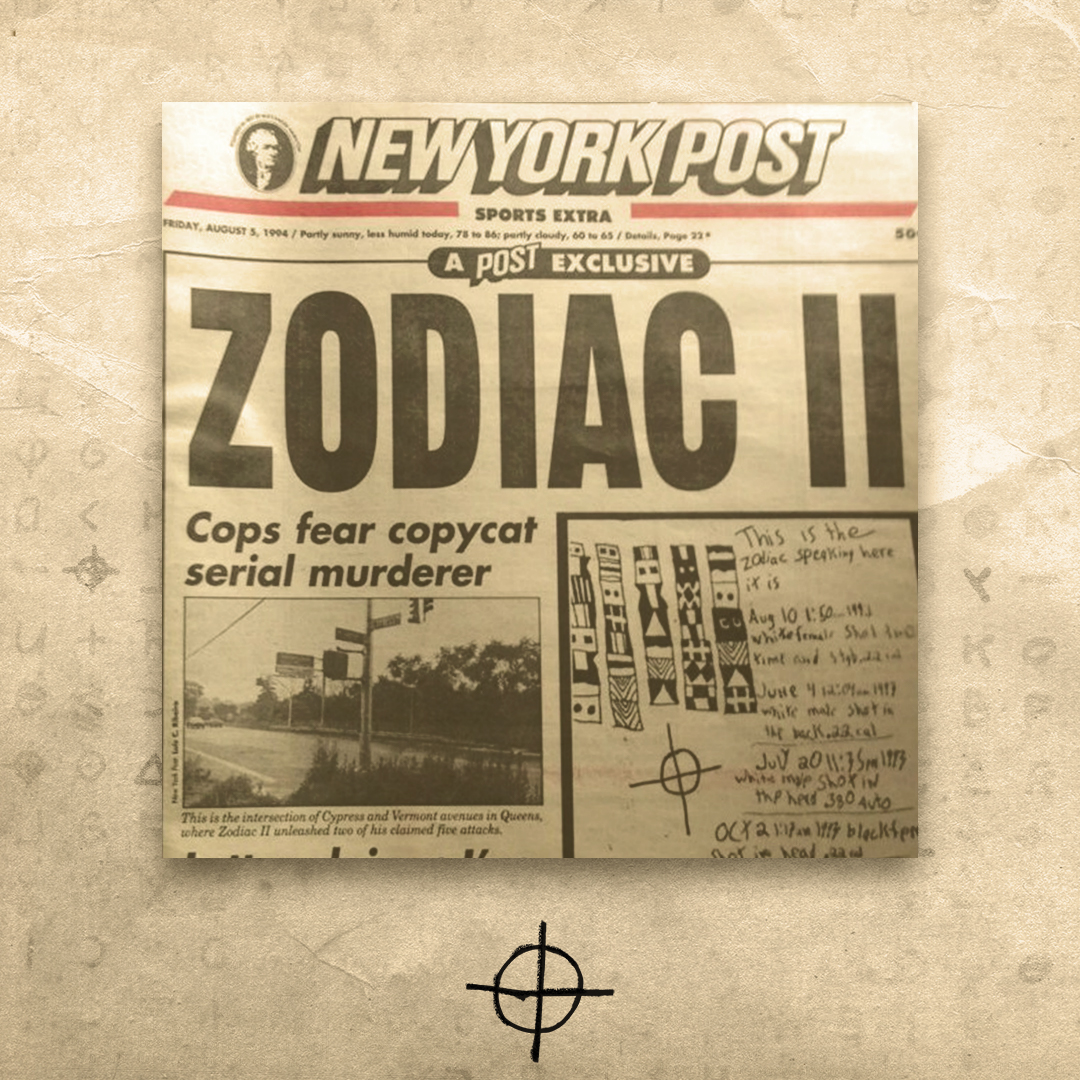
13 · Copycat
Fascination leads beyond obsession, as a new Zodiac emerges in New York City.
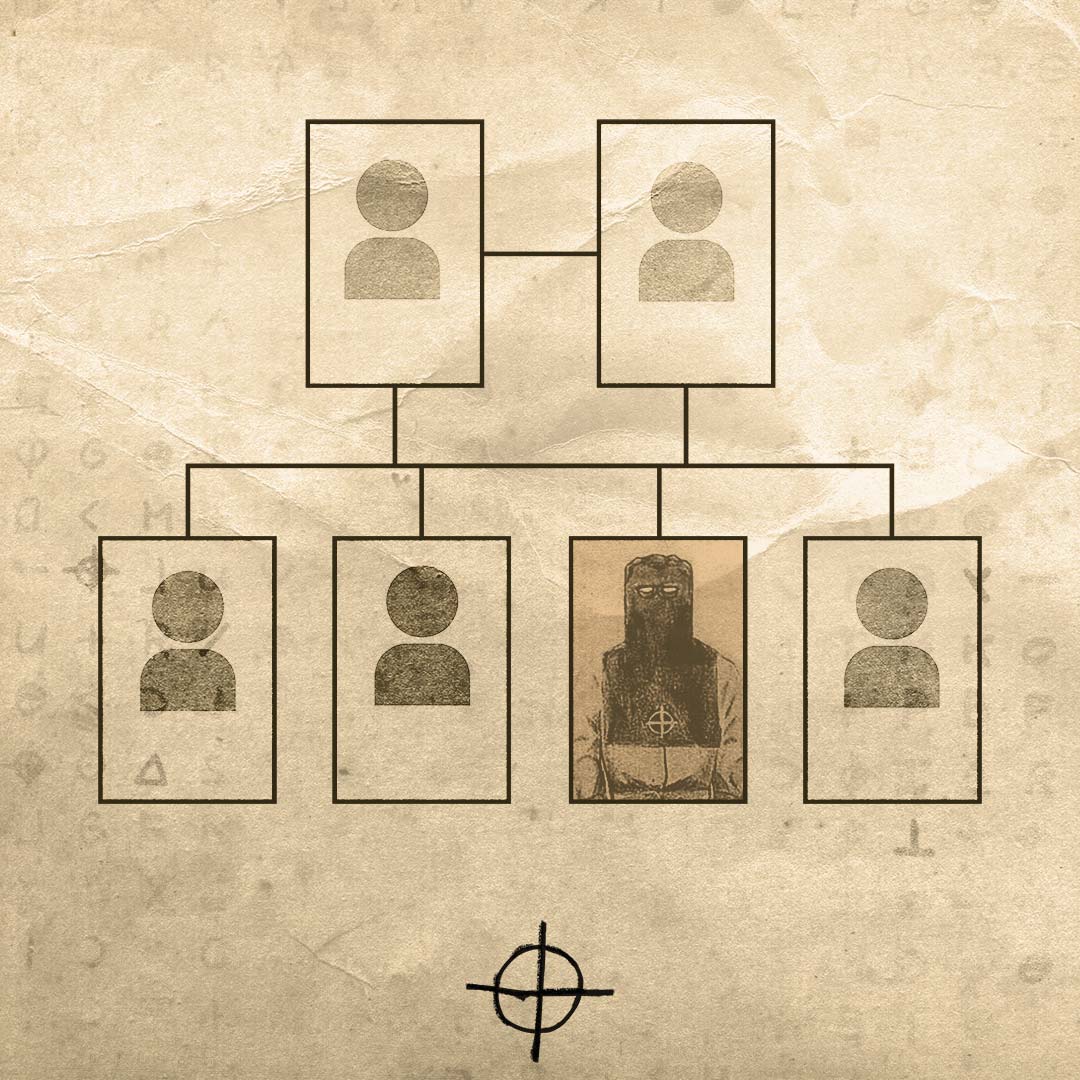
14 · Sequence
New technology brings fresh hope to the Zodiac case. But what if it’s still a dead end?

15 · Legacy
A frightening final theory.
